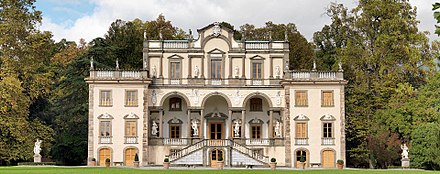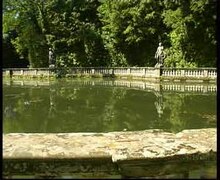Mansi villa
The Villa Mansi is located in Segromigno in Monte, via delle Selvette 242, a district of Capannori in the province of Lucca , Italy.
The Villa
In 1634/35, Countess Felice Cenami commissioned the Urbino- born architect Muzio Oddi to convert and enlarge the building, which belonged to the Benedetti family in 1599. He expanded the rectangular building with two side wings that protrude slightly and thereby structure the front.
Ottavio Mansi, who came from a respected family of silk merchants, bought the villa from the Cenami family in 1675. In 1742 Giovan Francesco Giusti had the central wing raised by one floor and a loggia, which is accessible via two staircases, and the villa decorated with balustrades and statues.
Luigi Mansi left the large salon decorated with the ceiling fresco Triumph of the Sun God by the Lucchese painter Stefano Tofanelli , the most important exponent of Lucchian neoclassicism.
The garden
Between 1725 and 1732, the famous architect Filippo Juvarra created a baroque garden for Ottavio Mansi with a ground floor, boxwood surrounds and water features. However, only a few of these elements survived the transformation into a romantic park in the 19th century. These include the partially preserved watercourse, the fish basin with a stone parapet, as well as a few mythological figures and the grotto of Diana.
The advent of the English Garden in Europe was greeted with great euphoria by the Lucchese nobility and wealthy bourgeoisie. The ground floor was replaced by meadows and numerous exotic plants and rare conifers found their way to Lucca, where they thrived thanks to the mild and humid climate. The camellia became the typical plant of this era. The list of exotic trees in Villa Mansi also mentions cedars, pines, palms, magnolias and of course camellias.
Legend of Lucida Mansi
Lucida was born in 1606 as the daughter of a noble family not from Lucca. In 1626 she married Vincenzo Diversi, who was murdered two years later under unexplained circumstances. In 1635 she married the much older Gaspero Mansi. Because of her extraordinary beauty she was the swarmed center of numerous festivals and her amorous adventures were topics of conversation in society. However, many of her admirers are said to have disappeared forever under mysterious circumstances. Lucida Mansi was so taken with her beauty that she had her bedroom covered with a mirror to admire herself. One day when she noticed the first signs of age, she made a pact with the devil that promised her flawless beauty for another 30 years for the dedication of her life. The legend reports its end in different versions. So when the hour came, she is said to have locked herself in her mirrored room, where her corpse, aged and eaten by worms, was later found. According to another version, she is said to have died of the plague in 1649, which is surprising since the villa was only acquired by the Mansis in 1675.
opening hours
- From April 1st to October 31st: from 10:00 a.m. to 1:00 p.m. and from 3:00 p.m. to 6:00 p.m.
- From November 1st to March 31st: from 10:00 a.m. to 1:00 p.m. and from 3:00 p.m. to 5:00 p.m.
- closed on Monday
literature
- Carlo Cresti: Villas in Tuscany. Recordings by Massimo Listri. Hirmer, Munich 1992, ISBN 3-7774-5920-8 .
- Massimo Listri, Cesare M. Cunaccia: Italian Gardens. Fascinating garden art from 5 centuries. Bassermann, Niedernhausen 2001, ISBN 3-8094-0998-7 .
further reading
- Germain Bazin : Du Mont's History of Garden Art. License issue. Komet, Frechen 1999, ISBN 3-933366-01-1 .
- Torsten Olaf Enge, Carl Friedrich Schröer: Garden art in Europe. 1450-1800. From the villa garden of the Italian Renaissance to the English landscape garden. Taschen, Cologne 1990, ISBN 3-8228-0402-9 .
- Marie Luise Gothein : History of garden art. Volume 1: From Egypt to the Renaissance in Italy, Spain and Portugal. 4th edition. Diederichs, Munich 1997, ISBN 3-424-013676-1 .
- Dieter Hennebo (ed.): Garden monument maintenance. Basics of the preservation of historical gardens and green spaces. Ulmer, Stuttgart 1985, ISBN 3-8001-5046-8 .
- Clemens Alexander Wimmer : Trees and bushes in historical gardens. Use of wood in history and monument preservation. Verlag der Kunst, Dresden 2001, ISBN 90-5705-148-6 ( Muskauer Schriften 3).
Web links
- http://www.villelucchesi.net/sito/villamansi.html
- http://www.villamansi.it
- http://brunelleschi.imss.fi.it/itineraries/place/VillaCenamiMansi.html
Coordinates: 43 ° 53 ′ 35.1 ″ N , 10 ° 35 ′ 27 ″ E

